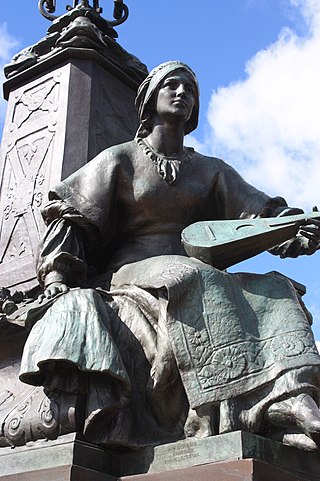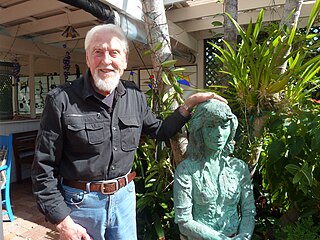Related Research Articles

Baron Sir Ferdinand Jacob Heinrich von Mueller, was a German-Australian physician, geographer, and most notably, a botanist. He was appointed government botanist for the then colony of Victoria, Australia by Governor Charles La Trobe in 1853, and later director of the Royal Botanic Gardens in Melbourne. He also founded the National Herbarium of Victoria. He named many Australian plants.

Royal Botanic Gardens Victoria are botanic gardens across two sites–Melbourne and Cranbourne.

Richard Daintree CMG was a pioneering Australian geologist and photographer. In particular, Daintree was the first Government geologist for North Queensland discovering gold fields and coal seams for future exploitation. Daintree was a pioneer in the use of photography during field trips and his photographs formed the basis of Queensland's contribution to the Exhibition of Arts and Industry in 1871. Following the success of the display, he was appointed as Queensland's Agent-General in London in 1872 but was forced to resign in 1876 due to ill-health and malpractice by some of his staff although not Daintree himself. A number of features in North Queensland have been named after Daintree including the town of Daintree, Queensland, the Daintree National Park, the Daintree River, the Daintree Rainforest which has been nominated for the World Heritage List and the Daintree Reef.

Kings Domain is an area of parklands in Melbourne, Victoria, Australia. It surrounds Government House Reserve, the home of the governors of Victoria, the Sidney Myer Music Bowl, and the Shrine Reserve incorporating the Shrine of Remembrance.

Samuel Thomas Gill, also known by his signature S.T.G., was an English-born Australian artist.

Johann Joseph Eugene von Guérard was an Austrian-born artist, active in Australia from 1852 until 1882. Known for his finely detailed landscapes in the tradition of the Düsseldorf school of painting, he is represented in Australia's major public galleries, and is referred to in the country as Eugene von Guerard.

Alfred William Howitt, , also known by author abbreviation A.W. Howitt, was an Australian anthropologist, explorer and naturalist. He was known for leading the Victorian Relief Expedition, which set out to establish the fate of the ill-fated Burke and Wills expedition.

Charles French was an Australian horticulturist, naturalist, entomologist and plant/seed collector who made significant contributions to economic entomology. French was the first economic entomologist in Australia and served as Government Entomologist in Victoria from 1889.

Paul Raphael Montford was an English-born sculptor, also active in Australia; winner of the gold medal of the Royal Society of British Sculptors in 1934.

Eucalyptus todtiana, commonly known as coastal blackbuttpricklybark or dwutta, is a species of tree or a mallee that is endemic to the west coast of Western Australia. It has rough, fibrous and flaky bark on the trunk, smooth bark on the branches, lance-shaped adult leaves, flower buds in groups of between seven and eleven, white flowers and cup-shaped to hemispherical fruit.

Clifford Frank Last OBE was a noted Australian modernist sculptor. Born in Barrow in Furness, England, he was the son of Nella Last, author of a World War II diary on which the TV film Housewife, 49 was based.

Thomas Lenton Parr AM was an Australian sculptor and teacher.
Muelleria is a peer-reviewed scientific journal on botany published by the Royal Botanic Gardens Melbourne. It focuses on topics relating to plants, algae, and fungi in the southern hemisphere and Australia in particular. The journal was named in honour of Victorian Government botanist Ferdinand von Mueller. Muelleria commenced publication in 1955 with funding from the Maud Gibson Trust. The trust was initiated in 1945 following the donation of £20,000 by Maud Gibson, a daughter of William Gibson, founder of the Foy & Gibson department store chain.
Joseph Anderson Panton was a Scottish-born Australian magistrate and goldfields commissioner.

Frederick Schoenfeld aka Fritz Schoenfeld, was a Swiss-born Australian artist, printmaker, lithographer and art teacher. He is noted for providing the illustrations for the 6 volumes (1859–68) of Fragmenta phytographiae Australiae by Ferdinand von Mueller, then director of the National Herbarium of Victoria, and for The Plants Indigenous to the Colony of Victoria (1860–65) and Analytical Drawings of Australian Mosses (1864).

Emil Fuchs was an Austrian–American sculptor, medallist, painter, and author who worked in Vienna, London and New York. He painted portraits of Queen Victoria and Edward VII and was fashionable among London high society in the early 20th century.
Hollandaea sayeriana, sometimes named Sayer's silky oak, is a small species of Australian rainforest trees in the plant family Proteaceae.

Marc Clark was a British-born Australian academic, sculptor and printmaker.

Samuel Calvert was a British draughtsman, printer and artist active in Australia, noted for his wood-engravings, published in contemporary periodicals. He was the third son of the renowned engraver and painter, Edward Calvert. During his period in Australia, Samuel Calvert produced hundreds of engraved illustrations for a variety of publications on a wide range of subjects. Calvert also designed postage stamps for the Victorian government. He was one of the founding members of the Victorian Academy of Art, formed in 1870, and showed watercolours and oil paintings at their subsequent exhibitions. Calvert left a legacy of finely-produced wood engravings depicting landscape, contemporary events and portraits.

Rosa Catherine Fiveash was an Australian botanical artist, illustrator and art teacher. She was a pioneer of china painting who introduced the technique to Adelaide.
References
- 1 2 3 4 5 6 7 "Emil Todt" . Retrieved 23 October 2007.
- ↑ Hall, Norman (1978). Botanists of the Eucalypts. Australia: Commonwealth Scientific and Industrial Research Organisation. ISBN 0-643-00271-5.
- ↑ Hewson, Helen (1999). Australia: 300 Years of Botanical Illustration. Collingwood, Victoria: CSIRO Publishing. ISBN 0-643-06366-8.